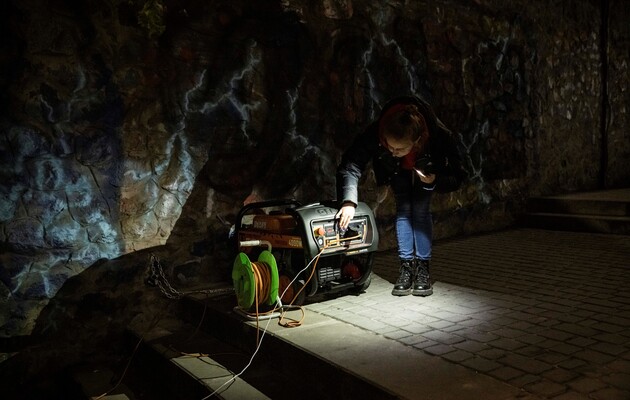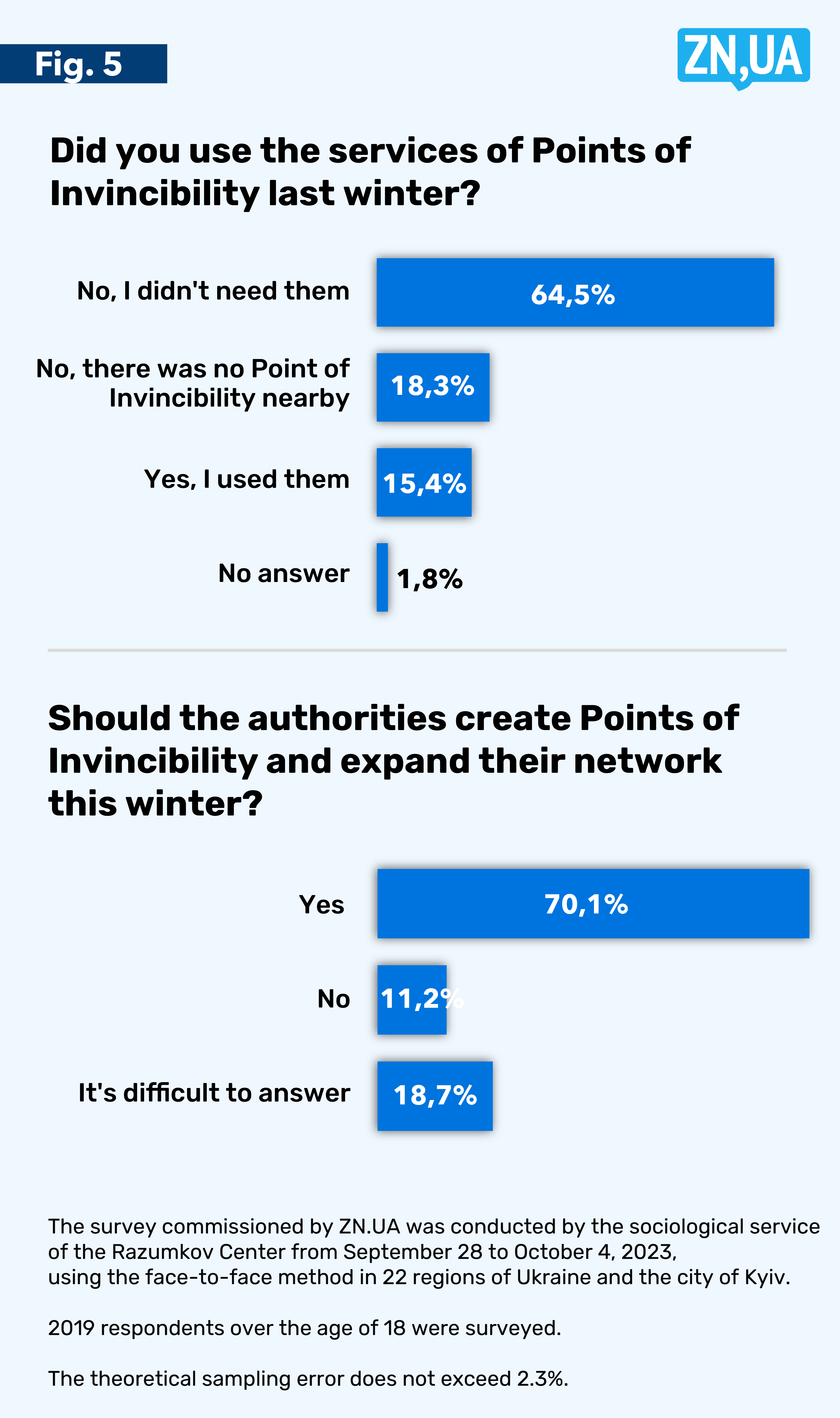Only 5% Of Ukrainians Plan To Leave Ukraine For The Winter, The Rest Are Not Afraid Of Energy Terror

The recent Russian fake about the schedules of multi-hour power outages, which was intended to create a hysterical tsunami in Ukrainian million-plus cities, and in the end only bubbled up unabashedly in some media outlets, proved that Ukrainians expect cold weather without unnecessary panic. This is confirmed by the results of our recent survey. Winter will show whether this calm is justified, but we can say for sure that one of the goals of the Russian energy terror – panic and further migration of Ukrainians – will not be achieved this year either.
Having enlisted the help of the sociological service of the Razumkov Center, ZN.UA asked Ukrainians whether they plan to leave Ukraine "for the winter" if the Russian Federation resorts to energy terror again? Only 5% of respondents answered "Yes", the majority (89%) chose the option "No", another 5.8% went for the option "It’s difficult to answer". People who have not yet left or who have already returned, at least do not tie their migration decisions to the availability of light and heating in their homes (see Fig. 1).
It would be logical to assume that this is the result of the experience of passing through the previous autumn-winter period, however, we did not see the expected unanimity in the answer to the question "Have you prepared for winter based on the experience of the previous heating season?" (see Fig. 2). Only 49% of respondents answered affirmatively, almost 35% chose the option "No", another 16% selected the option "It’s difficult to answer".
Alright, let's assume that this is the result of good preparation for the previous winter as everything needed for blackouts has long been available and waiting for its time. Fortunately, we had the results of a sociological survey conducted by the Razumkov Center from February 22 to March 1, 2023, regarding the availability of resources and facilities needed during prolonged power outages. So, we once again posed this question to Ukrainians in order to compare what exactly has changed over the year.
In fact, not much: the number of batteries for powering electrical appliances increased by 7.5% in the homes of Ukrainians, the number of power banks increased by 5%, and heating tools independent of centralized sources increased by almost 5%. Water reserves have decreased, but it is likely that at the time of the survey there was no need for their renewal. But in general, the changes are insignificant, most people, like last year, do not have electric generators at home (86.6%), batteries for powering household appliances (68.9%), solar panels (96.4%) and independent heating sources (62.2%). The main "saviors" from blackouts in Ukraine are power banks (68.3%), rechargeable lighting devices (54.5%) and water reserve (67%) (see Fig. 3).
Therefore, it is not surprising that some more thorough preparation, such as replacing windows or insulating homes, has not become widespread. This does not mean that people do not need such measures, but let's not forget that a large number of people are going through a rather difficult period in their lives, forced to save money and avoid unnecessary expenses. So, out of the answers to the question, "Have you done each of the following actions in preparation for the upcoming winter season?" the undisputed leader was also the most budgetary option "Stocked up with power banks, flashlights, batteries" (67.8%), another 41.7% of respondents bought a water tank, 36.6% purchased a heater (see Fig. 4).
Nevertheless, about a quarter of the respondents still noted that they had carried out minimal thermal modernization: they insulated the house (apartment) for winter (26.6%) and replaced the windows with better ones (23.7%). Also, 18.7% of respondents installed an air conditioner for heating, 18% switched to an Internet provider that provides Internet services even during blackouts, 15.9% purchased a backup power supply device, 12.4% purchased a generator, and 8.9 % replaced the boiler with a better one. Only 1.9% of respondents said that they bought Starlink in preparation for winter, which is not surprising, considering the cost of such a purchase.
Notably, the attitude of Ukrainians to the Points of Invincibility was frankly surprising (see Fig. 5). On the one hand, 64.5% of respondents answered that they never used their services last winter because they did not have such a need. On the other hand, 70% said that the authorities should set up Points of Invincibility and expand their network this winter. However, this typical Ukrainian "let it be" makes sense, because we have no chance to bypass the shortage of energy capacities.
The forecast balance from the Ministry of Energy foresees a deficit-free passage of winter, provided there are no destructions, which is impossible. Despite the fact that, in general, energy facilities have become more protected, this protection is far from ideal, as well as from the plans for this spring.
The decision of the National Security and Defense Council, which provides for the creation of a Plan of measures for the restoration of critical infrastructure facilities of the fuel and energy sector, was put into effect by the President by his decree on October 17. The document requires approval of the plan within three months, that is, somewhere before mid-January. What prevented it earlier is a mystery, as, according to our data, the draft of this document was developed back in February. Fortunately, the sector prepared as best it could for the heating season even without presidential instructions.
Shutdown schedules are not yet public, but have already been drawn up, as this is a mandatory part of preparing for any winter. They consider possible attacks on infrastructure, bottlenecks, and different response scenarios depending on possible losses of the power system.
On the good side, in addition to schedules, there is also backup equipment and ways to replace it under various scenarios of the development of events. But no one undertakes to guarantee the speed of these processes, because practice, especially in our conditions, will differ significantly from all possible scenarios.
Also, unfortunately, not all market participants managed to meet the deadlines for equipment repairs, and not so much because of laziness as because of the significant volume of work. This does not change the result though as part of the capacities will finish repairs only in November-December. It is clear that this is a risk for the entire energy system, and if we remember that in the summer we received emergency assistance 17 times, then the winter prospects, when the load on the energy system is much greater, are frankly disturbing.
Fortunately, we will at least replace expensive emergency aid with cheaper electricity imports. The import corridor available to us this winter to cover peak deficits is 1,200 MW. So far, we plan to attract only two hundred megawatts, so another thousand remains an inviolable reserve for critical cases. But the probability of critical cases is high, and the prospect that we will be able to increase the volume of imports at the moment is small. One should either contract the recourses now or hope for some miracle. Even if the latter happens, it is still not a guarantee that the light will be everywhere, because then everything will depend on the destruction and the speed of network restoration.
The government will offer uninterrupted power supply during power outages to businesses, whose stable operation in winter is also extremely important, provided that they import 50% of their own consumption. A significant note – last year the mandatory share of imports was one hundred percent. But there is one problem, the Ministry of Energy submitted the draft decision to the government just a few days ago, and it will take "several weeks" for its adoption.
The rate of accumulation of coal in warehouses is lagging behind. Our goal was 1.8 million tons, and we are still about 30% short of it. Replacing it with something other than gas is unlikely to succeed, and gas is also in short supply, and all calculations made by NJSC "Naftogaz of Ukraine" are based on last year's abnormally warm winter, and this year's forecasters' expectations are already different. So, the Ukrainians are right, we may need to deploy additional Points of Invincibility.
Please select it with the mouse and press Ctrl+Enter or Submit a bug
















 Login with Google
Login with Google